Mn Cluster-Embedded N/F Co-Doped Carbon toward Mild Aqueous Supercapacitors
Abstract
:1. Introduction
2. Materials and Methods
2.1. Materials
2.2. Sample Preparation
2.3. Sample Characterization
3. Results
3.1. Material Synthesis and Morphology
3.2. Material Characterization and Analysis
3.3. Electrode Electrochemical Performance Evaluation
3.4. Design of the Aqueous Asymmetric Supercapacitor
4. Conclusions
Supplementary Materials
Author Contributions
Funding
Institutional Review Board Statement
Informed Consent Statement
Data Availability Statement
Acknowledgments
Conflicts of Interest
References
- Beknalkar, S.A.; Teji, A.M.; Satale, V.V.; Amate, R.U.; Monrankar, P.U.; Yewale, M.A.; Shin, J.C. A critical review of recent advancements in high-temperature supercapacitors: Thermal kinetics, interfacial dynamics, employed strategies and prospective trajectories. Energy Storage Mater. 2024, 66, 103217. [Google Scholar] [CrossRef]
- Lee, H.; Jung, G.; Keum, K.; Kim, W.J.; Jeong, H.; Lee, Y.H.; Kim, D.S.; Ha, S.J. A textile-based temperature-tolerant stretchable supercapacitor for wearable electronics. Adv. Funct. Mater. 2021, 31, 2106491. [Google Scholar] [CrossRef]
- Chatterjee, D.P.; Nandi, A.K. A review on the recent advances in hybrid supercapacitors. J. Mater. Chem. A 2021, 9, 15880–15918. [Google Scholar] [CrossRef]
- Shin, S.J.; Gittins, J.W.; Balhatchet, C.J.; Walsh, A.; Forse, A.C. Metal–organic framework supercapacitors: Challenges and opportunities. Adv. Funct. Mater. 2023, 2308497. [Google Scholar] [CrossRef]
- Park, J.; Lee, J.; Kim, W. Redox-active water-in-salt electrolyte for high-energy-density supercapacitors. ACS Energy Lett. 2022, 7, 1266–1273. [Google Scholar] [CrossRef]
- Chen, J.; Lee, P.S. Electrochemical Supercapacitors: From Mechanism Understanding to Multifunctional Applications. Adv. Energy Mater. 2021, 11, 2003311. [Google Scholar] [CrossRef]
- Gaurav, T.; Ahmed, M.; Shah, F.U. Synthesis, thermoelectric and energy storage performance of transition metal oxides composites. Coord. Chem. Rev. 2024, 498, 215470. [Google Scholar]
- Khanam, Z.; Xiong, T.; Yang, F.; Su, H.; Luo, L.; Li, J.; Koroma, M.; Zhou, B.; Mushtaq, M.; Huang, Y.; et al. Endogenous Interfacial Mo-C/N-Mo-S Bonding Regulates the Active Mo Sites for Maximized Li+ Storage Areal Capacity. Small 2024, 2311773. [Google Scholar] [CrossRef] [PubMed]
- Mule, A.R.; Ramulu, B.; Arbaz, S.J.; Kurakula, A.; Jae, S.Y. Ag-integrated mixed metallic Co-Fe-Ni-Mn hydroxide composite as advanced electrode for high-performance hybrid supercapacitors. J. Energy Chem. 2024, 88, 579–591. [Google Scholar] [CrossRef]
- Lee, S.; An, G.H. Interface Engineering of Carbon Fiber-Based Electrode for Wearable Energy Storage Device. Adv. Fiber Mater. 2023, 5, 1749–1758. [Google Scholar] [CrossRef]
- Williams, R.E.; Sukumaran, S.; Abbas, Q.; Hunt, M.R.C. Few-layer graphene as an ‘active’ conductive additive for flexible aqueous supercapacitor electrodes. Carbon 2024, 218, 118744. [Google Scholar] [CrossRef]
- Jalalah, M.; Han, H.; Nayak, A.K.; Harraz, F.A. High Performance Supercapacitor Based on Self-heteroatom-doped Porous Carbon Electrodes Fabricated from Mikania Micrantha. Adv. Compos. Hybrid Mater. 2024, 7, 20. [Google Scholar] [CrossRef]
- Sanati, S.; Abazari, R.; Albero, J.; Morsali, A.; García, H.; Liang, Z.; Zou, R. Metal–organic framework derived bimetallic materials for electrochemical energy storage. Angew. Chem. Int. Ed. 2021, 60, 11048–11067. [Google Scholar] [CrossRef]
- Bai, J.; Mao, S.; Guo, F.; Shu, R.; Liu, S.; Dong, K.; Yu, Y.; Qian, L. Rapeseed meal-derived N,S self-codoped porous carbon materials for supercapacitors. New J. Chem. 2022, 46, 10752–10764. [Google Scholar] [CrossRef]
- Bian, Z.; Wang, H.; Zhao, X.; Ni, Z.; Zhao, G.; Chen, C.; Hu, G.; Komarneni, S. Optimized mesopores enable enhanced capacitance of electrochemical capacitors using ultrahigh surface area carbon derived from waste feathers. J. Colloid Interface Sci. 2023, 630, 115–126. [Google Scholar] [CrossRef]
- Ning, K.; Zhao, G.; Liu, H.; Hu, M.; Huang, F.; Li, H.; Zhang, L.; Zhu, G.; Wang, H.; Shi, J. N and S co-doped 3D hierarchical porous carbon as high-performance electrode material for supercapacitors. Diam. Relat. Mater. 2022, 126, 109080. [Google Scholar] [CrossRef]
- Abbas, S.C.; Hua, Z.; Deng, Q.; Ahommed, M.S.; Guo, J.; Huang, H.; Ma, X.; Cao, S.; Ni, Y. Natural polymers as sustainable precursors for scalable production of N/SOx doped carbon material enabling high-performance supercapacitors. EcoMat 2023, 6, e12434. [Google Scholar] [CrossRef]
- Pham, T.V.; Kim, J.G.; Jung, J.Y.; Kim, H.J.; Cho, H.; Seo, T.H.; Lee, H.; Kim, J.H.; Cho, H.; Seo, T.H.; et al. High areal capacitance of N-doped graphene synthesized by arc discharge. Adv. Funct. Mater. 2019, 29, 1905511. [Google Scholar] [CrossRef]
- Sanchez-Sanchez, A.; Lzquierdo, M.T.; Mathieu, S.; Ghanbaja, J.; Celzard, A.; Fierro, V. Structure and electrochemical properties of carbon nanostructures derived from nickel (II) and iron (II) phthalocyanines. J. Adv. Res. 2020, 22, 85–97. [Google Scholar] [CrossRef]
- Ghotbi, M.Y.; Sikiru, S.; Rajabi, A.; Soleimani, H.; Kou, L.; Ansari, M.N.M.; Ramachandaramurthy, V.K. ZnO/ZnS/Carbon Nanocomposite-Derived Sulfur-Doped carbon nanosheets using a layered nanoreactor: Towards advanced supercapacitor electrodes and devices. Chem. Eng. J. 2024, 485, 150018. [Google Scholar] [CrossRef]
- Han, X.; Wu, C.; Li, H.; Zhang, Y.; Sun, W.; Jia, B.; Gates, I.D.; Huang, Z.H.; Ma, T. Three-in-one alkylamine-tuned MoOx for lab-scale to real-life aqueous supercapacitors. Adv. Funct. Mater. 2022, 32, 2113209. [Google Scholar] [CrossRef]
- Ruan, J.; Mo, F.; Chen, Z.; Liu, M.; Zheng, S.; Wu, R.; Fang, F.; Song, Y.; Sun, D. Rational construction of nitrogen-doped hierarchical dual-carbon for advanced potassium-ion hybrid capacitors. Adv. Energy Mater. 2020, 10, 1904045. [Google Scholar] [CrossRef]
- Zheng, C.; Huang, Z.H.; Sun, F.F.; Zhang, Y.; Li, H.; Liu, Y.; Ma, T. Oxygen-Vacancy-Reinforced Vanadium Oxide/Graphene Heterojunction for Accelerated Zinc Storage with Long Life Span. Small 2024, 20, 2306275. [Google Scholar] [CrossRef] [PubMed]
- Yang, J.; Wang, B.; Jin, F.; Ning, Y.; Luo, H.; Zhang, J.; Wang, F.; Wang, D.; Zhou, Y. A MIL-47 (V) derived hierarchical lasagna-structured V2O3@C hollow microcuboid as an efficient sulfur host for high-performance lithium–sulfur batteries. Nanoscale 2020, 12, 4552–4561. [Google Scholar] [CrossRef] [PubMed]
- Wan, Z.; Xu, Z.; Sun, Y.; He, M.; Hou, D.; Cao, X.; Tsang, D.C. Critical impact of nitrogen vacancies in nonradical carbocatalysis on nitrogen-doped graphitic biochar. Environ. Sci. Technol. 2021, 55, 7004–7014. [Google Scholar] [CrossRef] [PubMed]
- Hu, X.; Wang, G.; Li, J.; Huang, J.; Liu, Y.; Zhong, G.; Yuan, J.; Zhan, H.; Wen, Z. Significant contribution of single atomic Mn implanted in carbon nanosheets to high-performance sodium–ion hybrid capacitors. Energy Environ. Sci. 2021, 14, 4564–4573. [Google Scholar] [CrossRef]
- Ju, W.; Bagger, A.; Hao, G.P.; Varela, S.A.; Sinev, I.; Bon, V.; Cuenya, B.R.; Kaskel, S.; Rossmeisl, J.; Strasser, P. Understanding activity and selectivity of metal-nitrogen-doped carbon catalysts for electrochemical reduction of CO2. Nat. Commun. 2017, 8, 944. [Google Scholar] [CrossRef]
- Deshmukh, S.; Kunuku, S.; Jakobczyk, P.; Olejnik, A.; Chen, C.H.; Niu, H.; Yang, B.; Yang, N.; Bogdanowicz, R. Diamond-Based Supercapacitors with Ultrahigh Cyclic Stability through Dual-Phase MnO2-Graphitic Transformation Induced by High-Dose Mn-Ion Implantation. Adv. Funct. Mater. 2024, 34, 2308617. [Google Scholar] [CrossRef]
- Shah, S.S.; Aziz, M.A.; Al-Betar, A.R.; Mahfoz, W. Electrodeposition of polyaniline on high electroactive indium tin oxide nanoparticles-modified fluorine doped tin oxide electrode for fabrication of high-performance hybrid supercapacitor. Arab. J. Chem. 2022, 15, 104058. [Google Scholar] [CrossRef]
- Luo, H.; Wang, B.; Wang, C.; Wu, F.; Jin, F.; Cong, B.; Ning, Y.; Zhou, Y.; Wang, D.; Liu, H.; et al. Synergistic deficiency and heterojunction engineering boosted VO2 redox kinetics for aqueous zinc-ion batteries with superior comprehensive performance. Energy Storage Mater. 2020, 33, 390–398. [Google Scholar] [CrossRef]
- Wang, Y.; Wie, S.; Qi, Z.H.; Chen, S.; Zhu, K.; Ding, H.; Cao, Y.; Zhou, Q.; Wang, C.; Zhang, P.; et al. Intercalant-induced V t2g orbital occupation in vanadium oxide cathode toward fast-charging aqueous zinc-ion batteries. Proc. Natl. Acad. Sci. USA 2023, 120, e2217208120. [Google Scholar] [CrossRef]
- Bezryadin, A.; Verschueren, A.R.M.; Tans, S.J.; Dekker, C. Multiprobe transport experiments on individual single-wall carbon nanotubes. Phys. Rev. Lett. 1998, 80, 4036. [Google Scholar] [CrossRef]
- Panicker, N.J.; Dutta, J.C.; Sahu, P.P. Confined growth of NiCo2S4 on 2D/2D porous carbon self-repairing g-C3N4/rGO heterostructure for enhanced performance of asymmetric supercapacitors. Chem. Eng. J. 2023, 463, 142376. [Google Scholar] [CrossRef]
- Baasanjav, E.; Senthamaraikannan, T.G.; Bandyopadhyay, P.; Lim, D.H.; Jeong, S.M. Quasi-solid-state hybrid supercapacitors assembled by Ni-Co-P@C/Ni-B nanoarrays and porous carbon nanofibers with N-doped C nanocages. Chem. Eng. J. 2023, 466, 143064. [Google Scholar] [CrossRef]
- Farashah, D.D.; Beigloo, F.; Zardkhoshoui, A.M.; Davarani, S.S.H. Boosting energy storage performance: An exploration of tellurium-based hollow FeNiCoTe nanocubes in hybrid supercapacitors. Chem. Eng. J. 2023, 474, 145584. [Google Scholar] [CrossRef]
- Antony, L.; Pavitra, E.; Ranjith, K.S.; Raju, G.S.R.; Huh, S.Y.; Han, Y.K. Ag Nanoparticles-Decorated Bimetal Complex Selenide 3D Flowers: A Solar Energy-Driven Flexible Hybrid Supercapacitor for Smart Wearables. Adv. Fiber Mater. 2024, 1–14. [Google Scholar] [CrossRef]
- Mun, W.J.; Kim, B.; Moon, S.J.; Kim, J.H. Hydrogen-bonded organic framework-derived, flower-on-fiber-like, carbon nanofiber electrode for supercapacitors. J. Mater. Chem. A 2024, 12, 6712–6723. [Google Scholar] [CrossRef]
- Lee, J.; Lim, T.S.; Jo, S.G.; Jeong, S.; Paik, H.; Ock, I.W.; Lee, S.; Yu, K.J.; Lee, J.W. Phase controlled Fe2N@Fe3O4 core-shell nanoparticles hybridized with nitrogen-doped reduced graphene oxide for boosted charge transfer in asymmetric supercapacitor. Chem. Eng. J. 2023, 476, 146515. [Google Scholar] [CrossRef]
- Delfani, E.; Habibzadeh, S.; Pourdayan, M.; Naji, L.; Ganjali, M.R. A 3D binder-free rGO/NiMnCo nanosheet for highly efficient hybrid supercapacitors and ion-selective capacitive deionization. J. Mater. Chem. A 2024, 12, 5947–5966. [Google Scholar] [CrossRef]
- Acharya, D.; Ko, T.H.; Bhattarai, R.M.; Alagan, M.; Kim, T.; Saidin, S.; Choi, J.S.; Chhetri, K.; Kim, H.Y. Double-phase engineering of cobalt sulfide/oxyhydroxide on metal-organic frameworks derived iron carbide-integrated porous carbon nanofibers for asymmetric supercapacitors. Adv. Compos. Hybrid Mater. 2023, 6, 179. [Google Scholar] [CrossRef]
- Khaladkar, S.R.; Maurya, O.; Gund, G.; Sinha, B.; Dubal, D.; Deshmukh, R.R.; Kalekar, A. Improving the charge kinetics through in-situ growth of NiSe nanoparticles on g-C3N4 nanosheets for efficient hybrid supercapacitors. J. Energy Chem. 2023, 87, 304–313. [Google Scholar] [CrossRef]
- Wang, Y.; Liu, R.; Tian, Y.; Sun, Z.; Huang, Z.; Wu, X.; Li, B. Heteroatoms-doped hierarchical porous carbon derived from chitin for flexible all-solid-state symmetric supercapacitors. Chem. Eng. J. 2019, 384, 123263. [Google Scholar] [CrossRef]
- Chen, Z.; Zhao, S.; Zhao, H.; Zou, Y.; Yu, C.; Zhong, W. Nitrogen-doped interpenetrating porous carbon/graphene networks for supercapacitor applications. Chem. Eng. J. 2021, 409, 127891. [Google Scholar] [CrossRef]
- Hao, J.; Wang, J.; Qin, S.; Liu, D.; Li, Y. B/N co-doped carbon nanosphere frameworks as high-performance electrodes for supercapacitors. J. Mater. Chem. A 2018, 6, 8053–8058. [Google Scholar] [CrossRef]
- Wei, X.; Wan, S.; Gao, S. Self-assembly-template engineering nitrogen-doped carbon aerogels for high-rate supercapacitors. Nano Energy 2016, 28, 206–215. [Google Scholar] [CrossRef]
- Qian, X.; Miao, L.; Jiang, J.; Ping, G.; Xiong, W.; Lv, Y.; Liu, Y.; Gan, L.; Zhu, D.; Liu, M. Hydrangea-like N/O codoped porous carbons for high-energy supercapacitors. Chem. Eng. J. 2020, 388, 124208. [Google Scholar] [CrossRef]
- Lu, H.; Yang, C.; Chen, J.; Li, H.; Wang, J.; Wang, S. Tailoring Hierarchically Porous Nitrogen-, Sulfur-Codoped Carbon for High-Performance Supercapacitors and Oxygen Reduction. Small 2020, 16, 190584. [Google Scholar] [CrossRef] [PubMed]
- Chen, H.; Liu, T.; Mou, J.; Zhang, W.; Jiang, Z.; Liu, J.; Huang, J.; Liu, M. Free-standing N-self-doped carbon nanofiber aerogels for high-performance all-solid-state supercapacitors. Nano Energy 2019, 63, 103836. [Google Scholar] [CrossRef]
- Miao, L.; Zhu, D.; Liu, M.; Duan, H.; Wang, Z.; Lv, Y.; Gan, Y. Cooking carbon with protic salt: Nitrogen and sulfur self-doped porous carbon nanosheets for supercapacitors. Chem. Eng. J. 2018, 347, 233–242. [Google Scholar] [CrossRef]
- Zhao, G.; Chen, C.; Yu, D.; Sun, L.; Yang, C.; Zhang, H.; Sun, Y.; Besenbacher, F.; Yu, M. One-Step Production of O-N-S Co-Doped Three-Dimensional Hierarchical Porous Carbons for High-Performance Supercapacitors. Nano Energy 2018, 47, 547–555. [Google Scholar] [CrossRef]
- Yoon, Y.; Lee, M.; Kim, S.K.; Bae, G.; Song, W.; Sung, M.; Lim, J.; Lee, S.S.; Zyung, T.; An, K.S. A Strategy for Synthesis of Carbon Nitride Induced Chemically Doped 2D MXene for High-Performance Supercapacitor Electrodes. Adv. Energy Mater. 2018, 8, 1703173. [Google Scholar] [CrossRef]
- Zhou, J.; Hou, L.; Lian, J.; Cheng, W.; Wang, D.; Gou, H.; Gao, F. Nitrogen-doped highly dense but porous carbon microspheres with ultrahigh volumetric capacitance and rate capability for supercapacitors. J. Mater. Chem. A 2019, 7, 476–485. [Google Scholar] [CrossRef]
- Hou, L.; Yang, W.; Li, Y.; Wang, P.; Jiang, B.; Xu, C.; Zhang, C.; Huang, G.; Yang, F.; Li, Y. Dual-template endowing N, O co-doped hierarchically porous carbon from potassium citrate with high capacitance and rate capability for supercapacitors. Chem. Eng. J. 2021, 417, 129289. [Google Scholar] [CrossRef]
- Li, Z.; Liu, X.; Wang, L.; Bu, F.; Wei, J.; Pan, D.; Wu, M. Hierarchical 3D All-Carbon Composite Structure Modified with N-Doped Graphene Quantum Dots for High-Performance Flexible Supercapacitors. Small 2018, 14, 1801498. [Google Scholar] [CrossRef]
- Deng, X.; Li, J.; Zhu, S.; Ma, L.; Zhao, N. Boosting the capacitive storage performance of MOF-derived carbon frameworks via structural modulation for supercapacitors. Energy Storage Mater. 2019, 23, 491–498. [Google Scholar] [CrossRef]
- Kale, V.S.; Hwang, M.; Chang, H.; Kang, J.; Chae, I.S.; Jeon, Y.; Yang, J.; Kim, J.; Ko, Y.J.; Piao, Y.; et al. Microporosity-Controlled Synthesis of Heteroatom Codoped Carbon Nanocages by Wrap-Bake-Sublime Approach for Flexible All-Solid-State-Supercapacitors. Adv. Funct. Mater. 2018, 28, 1803786. [Google Scholar] [CrossRef]
- Peng, Z.; Hu, Y.; Wang, J.; Liu, S.; Li, C.; Jiang, Q.; Lu, J.; Zeng, X.; Peng, P.; Li, F.F. Fullerene-Based In Situ Doping of N and Fe into a 3D Cross-Like Hierarchical Carbon Composite for High-Performance Supercapacitors. Adv. Energy Mater. 2019, 9, 1802928. [Google Scholar] [CrossRef]
- Peng, H.; Yao, B.; Wie, X.; Liu, T.; Kou, T.; Xiao, P.; Zhang, Y.; Li, Y. Pore and Heteroatom Engineered Carbon Foams for Supercapacitors. Adv. Energy Mater. 2019, 9, 1803665. [Google Scholar] [CrossRef]
- Cao, F.; Zhao, M.; Yu, Y.; Chen, B.; Huang, Y.; Yang, J.; Cao, X.; Lu, Q.; Zhang, X.; Zhang, Z.; et al. Synthesis of Two-Dimensional CoS1.097/Nitrogen-Doped Carbon Nanocomposites Using Metal-Organic Framework Nanosheets as Precursors for Supercapacitor Application. J. Am. Chem. Soc. 2016, 138, 6924–6927. [Google Scholar] [CrossRef] [PubMed]
- Chen, L.F.; Zhang, X.D.; Liang, H.W.; Kong, M.; Guan, Q.F.; Chen, P.; Wu, Z.Y.; Yu, S.H. Synthesis of nitrogen-doped porous carbon nanofibers as an efficient electrode material for supercapacitors. ACS Nano 2012, 6, 7092–7102. [Google Scholar] [CrossRef]
- Li, H.; Li, J.; Thomas, A.; Liao, Y. Ultra-High Surface Area Nitrogen-Doped Carbon Aerogels Derived from a Schiff-Base Porous Organic Polymer Aerogel for CO2 Storage. Adv. Funct. Mater. 2019, 28, 1904785. [Google Scholar] [CrossRef]
- Chen, C.; Yu, D.; Zhao, G.; Du, B.; Tang, W.; Sun, L.; Sun, Y.; Besenbacher, F.; Yu, M. Three-dimensional scaffolding framework of porous carbon nanosheets derived from plant wastes for high-performance supercapacitors. Nano Energy 2016, 27, 377–389. [Google Scholar] [CrossRef]
- Yao, L.; Wu, Q.; Zhang, P.; Zhang, J.; Wang, D.; Li, Y.; Ren, X.; Mi, H.; Deng, L.; Zheng, Z. Scalable 2D Hierarchical Porous Carbon Nanosheets for Flexible Supercapacitors with Ultrahigh Energy Density. Adv. Mater. 2018, 30, 1706054. [Google Scholar] [CrossRef]
- Yuksel, R.; Buyukcakir, O.; Panda, P.K.; Lee, S.H.; Jiang, Y.; Singh, D.; Hansen, S.; Adelung, R.; Mishra, Y.K.; Ahujia, R.; et al. Necklace-like Nitrogen-Doped Tubular Carbon 3D Frameworks for Electrochemical Energy Storage. Adv. Funct. Mater. 2020, 30, 1909725. [Google Scholar] [CrossRef]
- Li, Y.; Zheng, S.; Liu, X.; Li, P.; Sun, L.; Yang, R.; Wang, S.; Wu, Z.S.; Bao, X.; Deng, W.Q. Conductive Microporous Covalent Triazine-Based Framework for High-Performance Electrochemical Capacitive Energy Storage. Angew. Chem. Int. Ed. 2018, 57, 7992–7996. [Google Scholar] [CrossRef]
- Ding, C.; Liu, T.; Yan, X.; Huang, L.; Ryu, S.; Lan, J.; Yu, Y.; Zhong, W.H.; Yang, X. An ultra-microporous carbon material boosting integrated capacitance for cellulose-based supercapacitors. Nano-Micro Lett. 2020, 12, 1–17. [Google Scholar] [CrossRef]
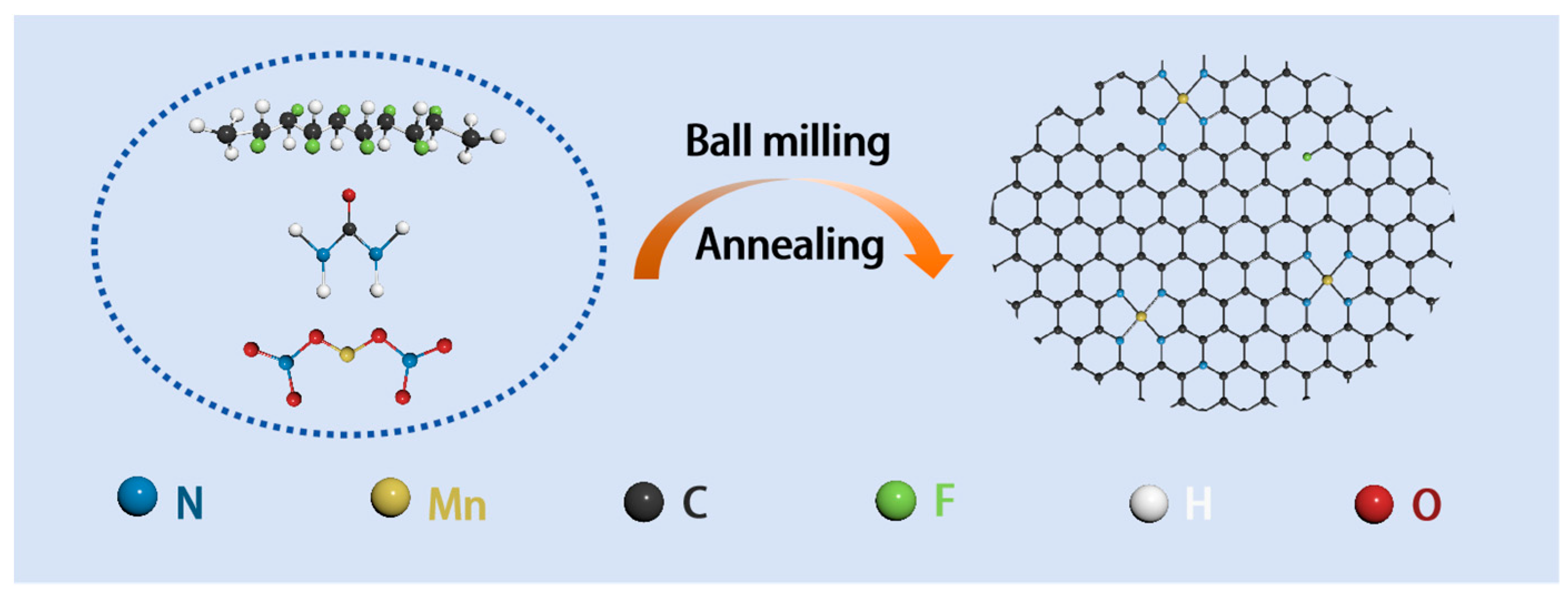
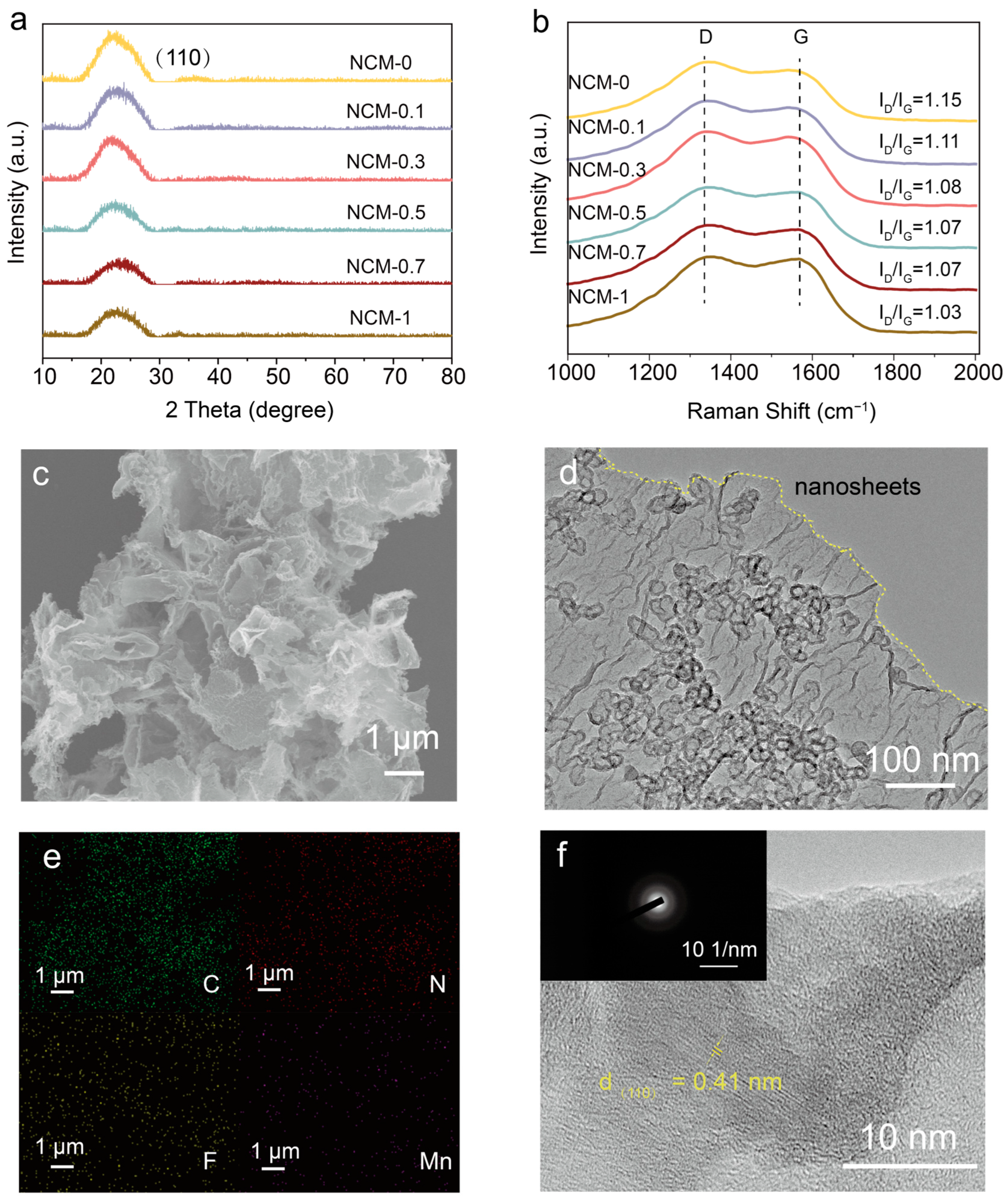
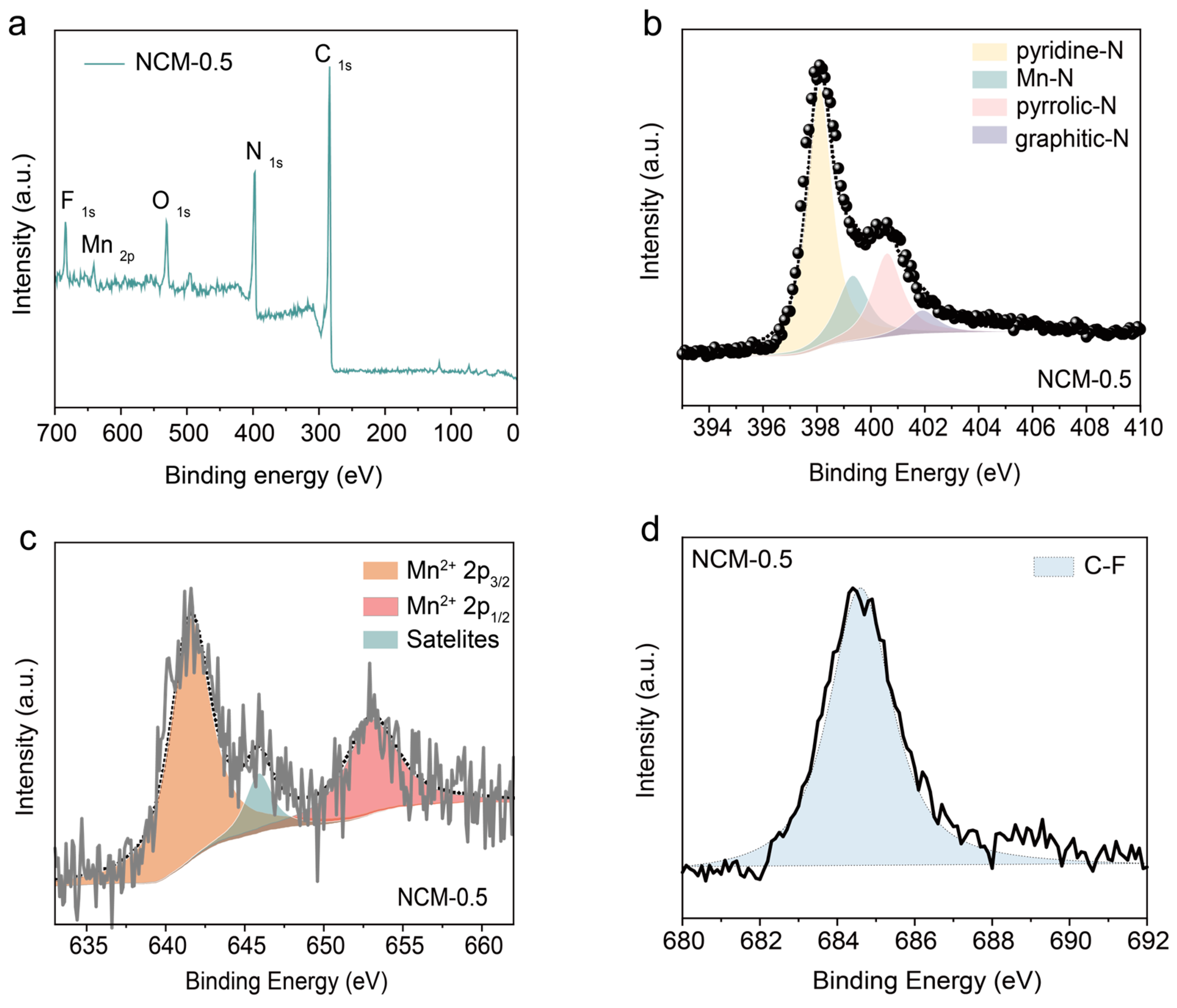
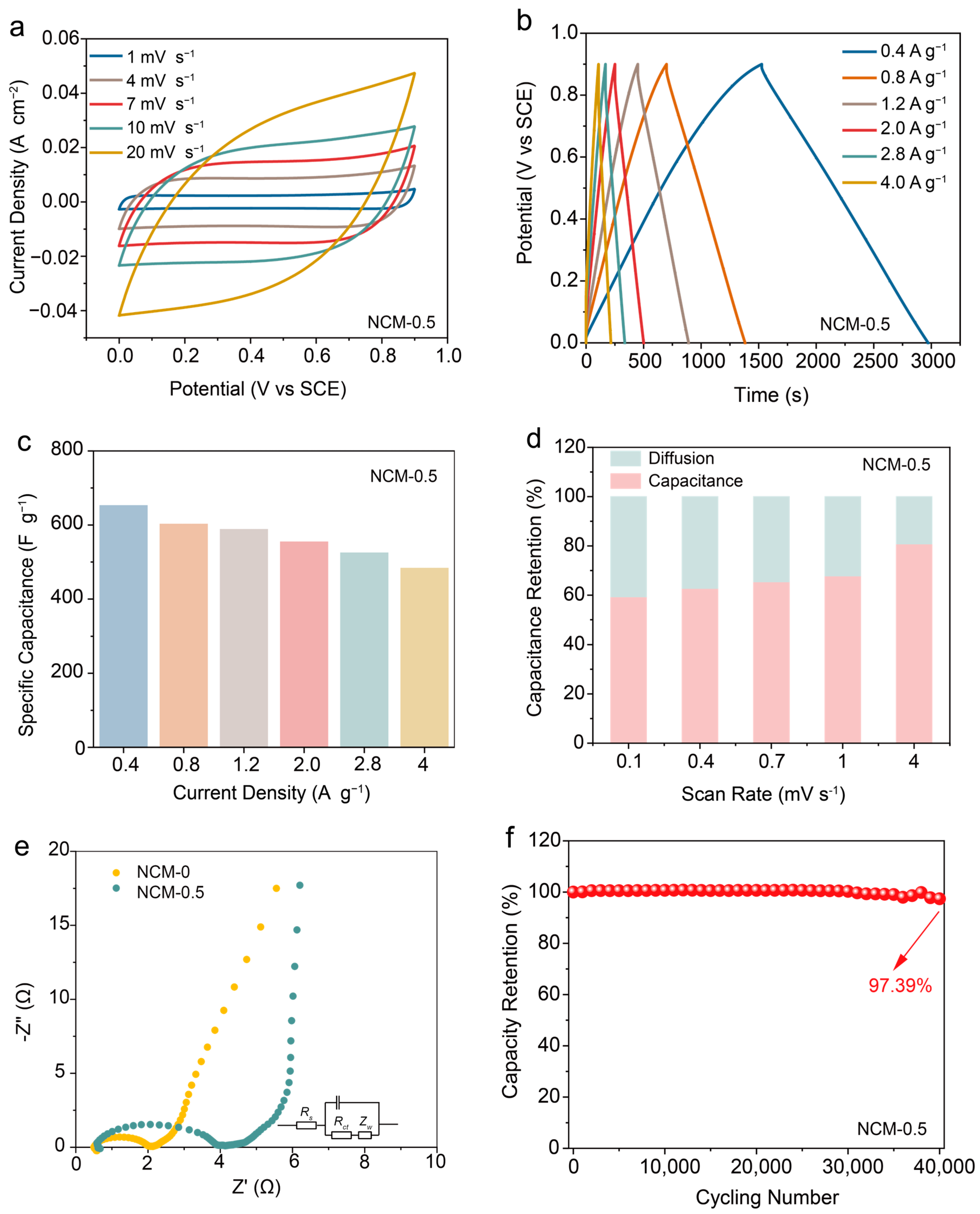
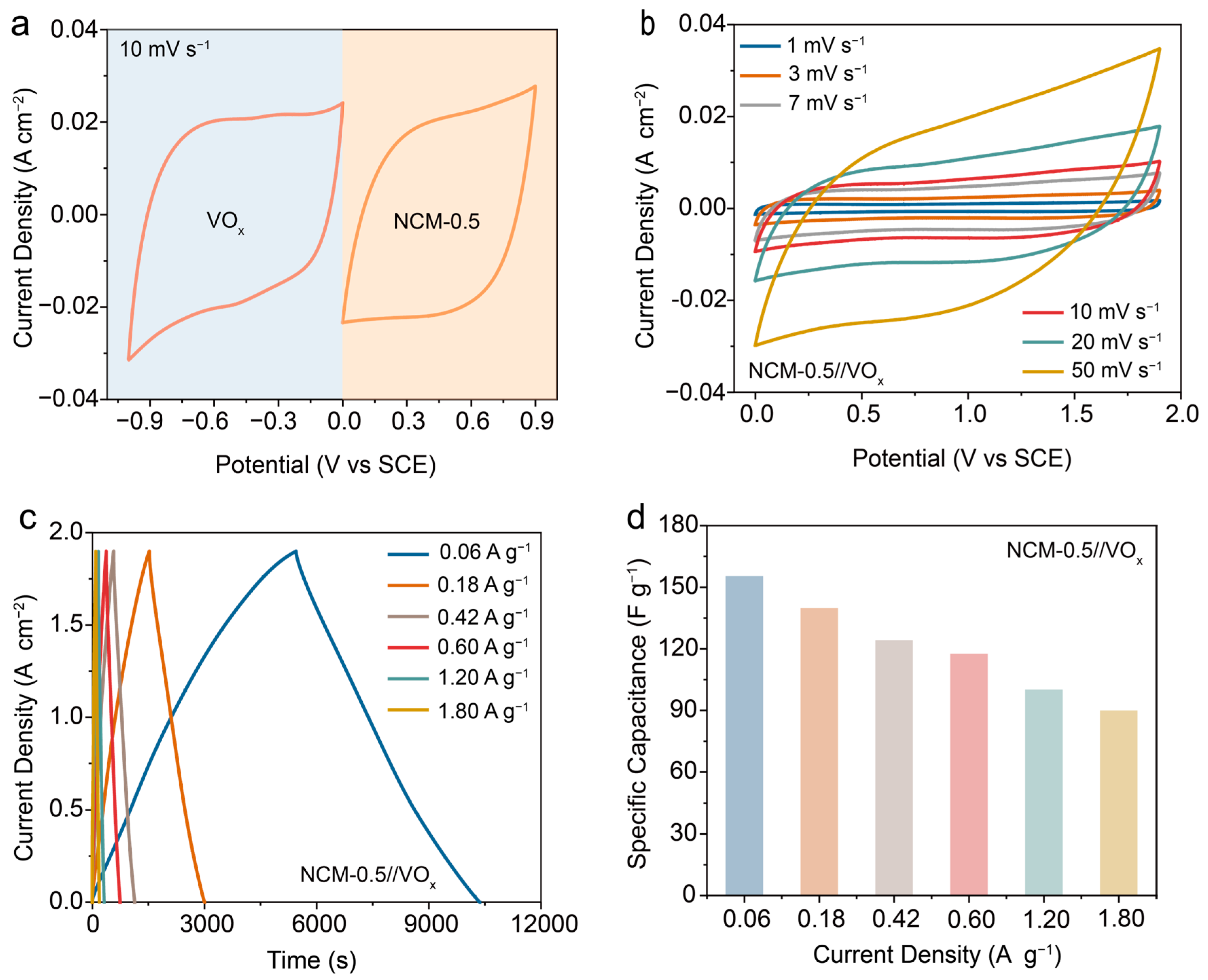
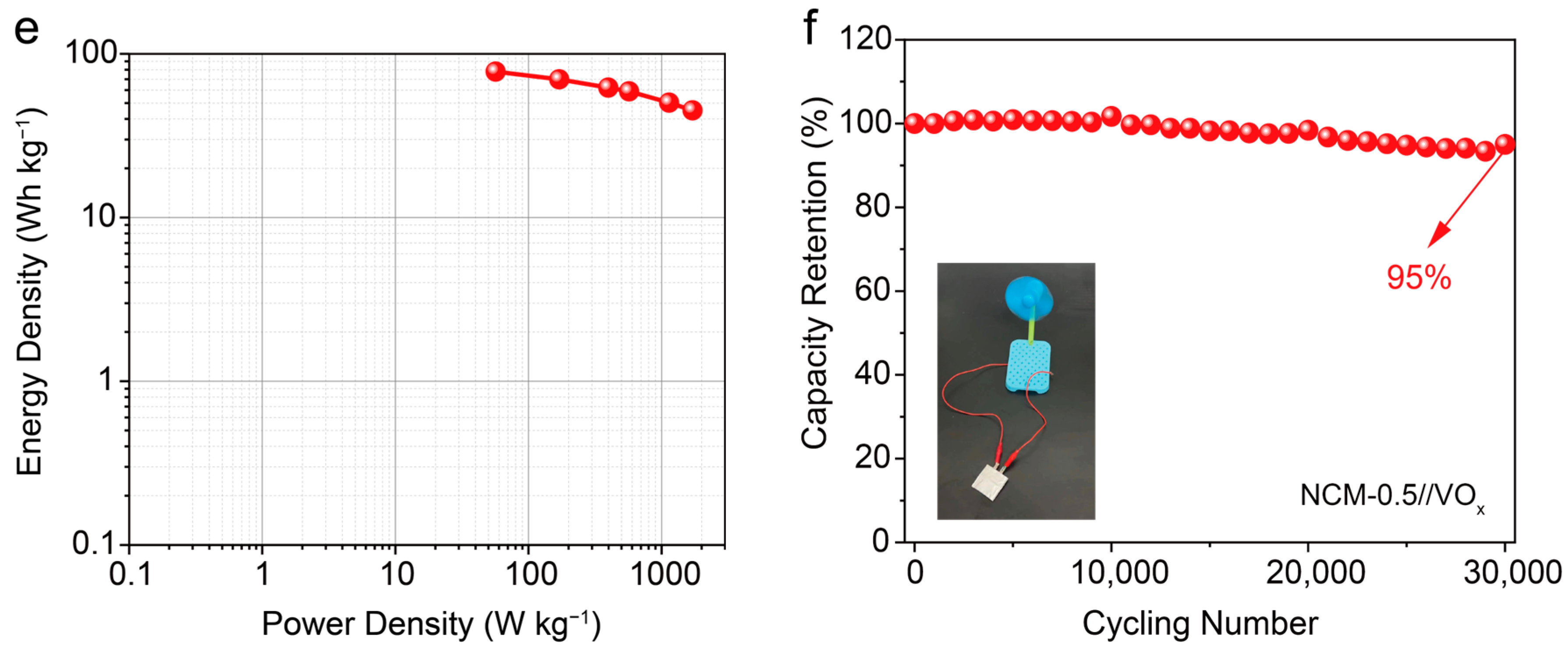
| Sample | Pyridine-N | Mn-N | Pyrrolic-N | Graphitic-N |
|---|---|---|---|---|
| NCM-0 | 60.7% | 0% | 17.9% | 21.4% |
| NCM-0.1 | 58.5% | 8.6% | 22.7% | 10.2% |
| NCM-0.3 | 57.0% | 13.8% | 19.4% | 9.9% |
| NCM-0.5 | 55.2% | 17.8% | 21.0% | 6.0% |
| NCM-0.7 | 61.4% | 14.8% | 16.1% | 7.8% |
| NCM-1 | 63.3% | 11.8% | 17.0% | 7.9% |
| Sample | Energy Density (Wh kg−1) | Power Density (W kg−1) | Ref. |
|---|---|---|---|
| g-C3N4/rGO@NiCo2S4//AC | 66 | 751 | [33] |
| Ni-Co-P@C/Ni-B//HP-N-CFs | 68.3 | 985 | [34] |
| FeNiCoTe//AC | 62.9 | 806.4 | [35] |
| NiV2Se4-Ag//AC | 77 | 749 | [36] |
| c-PAN@MCA0.25//c-PAN@MCA0.25 | 11.4 | 344 | [37] |
| Fe2N@Fe3O4/NrGO//Ni2O/rGO | 28.6 | 825 | [38] |
| rGO/NiMnCo-OH//AC | 66.9 | 800 | [39] |
| Co1-xS/HCoO2-1@Fe3C/PCNFs//Fe2O3/NPC@PCNFs | 65.68 | 752.7 | [40] |
| NiSe/g-C3N4//AC | 52.5 | 1488 | [41] |
Disclaimer/Publisher’s Note: The statements, opinions and data contained in all publications are solely those of the individual author(s) and contributor(s) and not of MDPI and/or the editor(s). MDPI and/or the editor(s) disclaim responsibility for any injury to people or property resulting from any ideas, methods, instructions or products referred to in the content. |
© 2024 by the authors. Licensee MDPI, Basel, Switzerland. This article is an open access article distributed under the terms and conditions of the Creative Commons Attribution (CC BY) license (https://creativecommons.org/licenses/by/4.0/).
Share and Cite
Zheng, C.; Han, X.; Sun, F.; Zhang, Y.; Huang, Z.; Ma, T. Mn Cluster-Embedded N/F Co-Doped Carbon toward Mild Aqueous Supercapacitors. Materials 2024, 17, 1417. https://doi.org/10.3390/ma17061417
Zheng C, Han X, Sun F, Zhang Y, Huang Z, Ma T. Mn Cluster-Embedded N/F Co-Doped Carbon toward Mild Aqueous Supercapacitors. Materials. 2024; 17(6):1417. https://doi.org/10.3390/ma17061417
Chicago/Turabian StyleZheng, Chen, Xu Han, Fangfang Sun, Yue Zhang, Zihang Huang, and Tianyi Ma. 2024. "Mn Cluster-Embedded N/F Co-Doped Carbon toward Mild Aqueous Supercapacitors" Materials 17, no. 6: 1417. https://doi.org/10.3390/ma17061417




